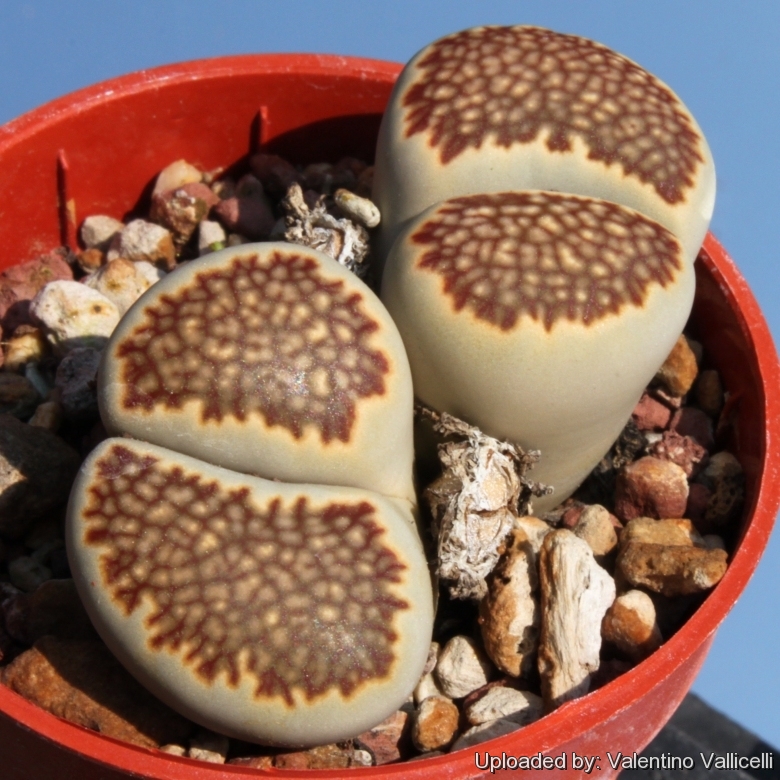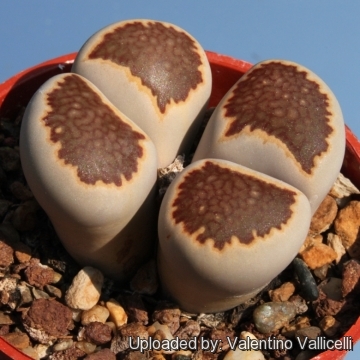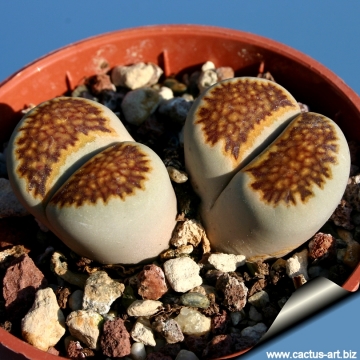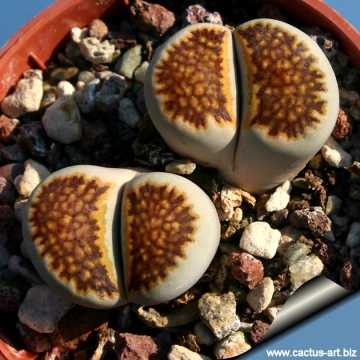Accepted Scientific Name: Lithops julii
Gard. Chron. 1926, Ser. III. lxxix. 102.

Lithops julii f. fuscus Photo by: Valentino Vallicelli
Has mottled milky grey and rich brown top.
Origin and Habitat: Namibia
Synonyms:
See all synonyms of Lithops julii
back
Accepted name in llifle Database:Lithops julii (Dinter & Schwantes) N.E.Br.Gard. Chron. 1926, Ser. III. lxxix. 102.Synonymy: 19
Accepted name in llifle Database:Lithops julii subs. fulleri (N.E.Br.) B.FearnNatl. Cact. Succ. J. 31 (3) 59 [Set. 1976]Synonymy: 29
- Lithops julii subs. fulleri (N.E.Br.) B.Fearn
- Lithops julii subs. fulleri var. brunnea de Boer
- Lithops julii subs. fulleri var. brunnea C179 TL: 10 km NE of Pofadder, South Africa
- Lithops julii subs. fulleri C024 5 km N of Kenhardt, South Africa
- Lithops julii subs. fulleri C056 25 km SW of Pofadder, South Africa
- Lithops julii subs. fulleri C062 Near Kakamas, South Africa
- Lithops julii subs. fulleri C121 115 km W of Kenhardt, South Africa
- Lithops julii subs. fulleri C122 125 km W of Kenhardt, South Africa
- Lithops julii subs. fulleri C161 Near Pofadder, South Africa
- Lithops julii subs. fulleri C162A 70 km WSW of Pofadder, South Africa
- Lithops julii subs. fulleri C171 60 km W of Upington, South Africa
- Lithops julii subs. fulleri C203 15 km SSE of Kenhardt, South Africa
- Lithops julii subs. fulleri C230B 75 k
- Lithops julii subs. fulleri C259 40 km ENE of Gamoep, South Africa
- Lithops julii subs. fulleri C319 5 km NE of Pofadder, South Africa
- Lithops julii subs. fulleri C323 25 km SW of Upington, South Africa
- Lithops julii subs. fulleri C378 65 km NE of Springbok, South Africa
- Lithops julii subs. fulleri C416 E of Onseepkans, South Africa
- Lithops julii subs. fulleri var. rouxii (de Boer) D.T.Cole
- Lithops julii var. rouxii C215 75 km WSW of Warmbad, Namibia
- Lithops julii var. rouxii C216 60 km WSW of Warmbad, Namibia
- Lithops julii var. rouxii C217 70 km WSW of Warmbad, Namibia
- Lithops julii var. rouxii C324 55 km W of Warmbad, Namibia
- Lithops maughanii N.E.Br.
Cultivars
(3):
back
Description: Lithops juliiSN|13037]]SN|13037]] is a very pretty species conspicuously pale, usually pearl- to pink-grey leaves but very variable in colour, with characteristic “lip-smears” which is a distinctive feature of this species. The lip-smear occurs occasionally as a narrow edging or lining all along the outer margins. Three main forms have been proposed and were even given varietal status (“pallid”, “reticulated” and “fuscous”) but wild populations tend to have at least two and many have all three of this forms variously intermingled. The “fuscous” form has mottled milky grey and dark brown top.
Habit: Lithops juliiSN|13037]]SN|13037]] is a stemless small to medium sized species that grows solitary or forming clumps of 2 or up to 15 or more) bodies.
Body (paired leaves): Cone-shaped, truncate, separated by a 5-10 mm deep fissure with (usually) conjunct lobes. Face slightly reniform flat or slightly convex; sides coloured pate to very pate (bordering on slightly yellowish-white); in the young stage rugulose, the islands irregular in shape, coloured same as sides; the depressions of a dark yellowish-brown colouration forming a fairly broad network, in the depressions isolated dark red dots and very short prominent, broad dark-red tines, sometimes all the tines interconnected with one another, thereby giving the whole depression a deeper tint; in the older stage the islands are fewer, due to the depressions flowing into one another and forming a fairly large window of a much tighter colour, with here and there the remains of a dot or tine; these entirely absent afterwards, giving the whole a much tighter colour and the appearance of a different plant; the islands verging on white and the depressions a pate grey-green colour; in the later stage the outer margin with teeth of irregular shape and size; inner margins straight; in the very old leaves blue-green dots. This species is very variable some specimens being opaque whitish-grey and almost uniform in colour, others opaque but strongly reticulated with fine impressed brown markings, yet others with largely open obscurely translucent windows.
Flowers: Single, white, daisy-like, about 3 cm in diameter, emerging from the fissure and as large as the pair of fleshy leaves below.
Blooming season: From mid-summer through fall.
Fruit: Seed capsules mostly 6-loculed, top more or less flat, faces elliptic.
Seeds: Yellow-brown to light yellow-brown.
Subspecies, varieties, forms and cultivars of plants belonging to the Lithops julii group
 Lithops julii (Dinter & Schwantes) N.E.Br.: Cole numbers: C063, C064, C183, C297, C349 (chrysocephala) C205; (littlewoodii) C218. The more distinctive feature of this plant is a brown 'lip-smear' along the inner margins. Three main forms have been proposed and were even given varietal status (“pallid”, “reticulated” and “fuscous”) but wild populations have all three of this forms variously intermingled. Distribution: Namibia
Lithops julii (Dinter & Schwantes) N.E.Br.: Cole numbers: C063, C064, C183, C297, C349 (chrysocephala) C205; (littlewoodii) C218. The more distinctive feature of this plant is a brown 'lip-smear' along the inner margins. Three main forms have been proposed and were even given varietal status (“pallid”, “reticulated” and “fuscous”) but wild populations have all three of this forms variously intermingled. Distribution: Namibia Lithops julii C063 60 km SE of Warmbad, Namibia D.T.Cole: extremely variable pattern.
Lithops julii C063 60 km SE of Warmbad, Namibia D.T.Cole: extremely variable pattern. Lithops julii C064 Near Karasburg, Namibia D.T.Cole: stunning network, variable.
Lithops julii C064 Near Karasburg, Namibia D.T.Cole: stunning network, variable.- Lithops julii C183 25 km SE of Warmbad, Namibia: open jagged pattern, variable.
 Lithops julii C205 (syn. chrysocephala) 50 km SE of Warmbad, Namibia: pale milky grey body.
Lithops julii C205 (syn. chrysocephala) 50 km SE of Warmbad, Namibia: pale milky grey body. Lithops julii C218 (syn. littlewoodii) TL: 40 km WSW of Warmbad, Namibia: pinkish jagged top.
Lithops julii C218 (syn. littlewoodii) TL: 40 km WSW of Warmbad, Namibia: pinkish jagged top. Lithops julii C297 45 km SE of Warmbad, Namibia: big light grey body, indented lines.
Lithops julii C297 45 km SE of Warmbad, Namibia: big light grey body, indented lines. Lithops julii C297A TL: 45 km SE of Warmbad, Namibia cv. Peppermint Crème D.T.Cole: Very distictive blue-green form derived from only one specimen collected by Leslie Pretorius in 1983 in Namibia. Margins and islands very pale milky bluish green and shoulders a little lighter than the margins. Lip-smears pale brownish green. Channels opaque pale milky bluish grey.
Lithops julii C297A TL: 45 km SE of Warmbad, Namibia cv. Peppermint Crème D.T.Cole: Very distictive blue-green form derived from only one specimen collected by Leslie Pretorius in 1983 in Namibia. Margins and islands very pale milky bluish green and shoulders a little lighter than the margins. Lip-smears pale brownish green. Channels opaque pale milky bluish grey.- Lithops julii C349 45km South-East of Warmbad, Namibia: pink grey with brown spots.
 Lithops julii subs. fulleri (N.E.Br.) B.Fearn: Cole numbers: C024, C056, C062, C121, C122, C161, C162A, C171, C203, C230B, C259, C319, C323, C378
Lithops julii subs. fulleri (N.E.Br.) B.Fearn: Cole numbers: C024, C056, C062, C121, C122, C161, C162A, C171, C203, C230B, C259, C319, C323, C378
This is an extremely variable subspecies in colour, pattern and rubrication. Shoulders, margins and islands light grey, often tinged with pink, yellow, blue or green, or beige. Windows and channels milky blue, pale pinkish, greenish or yellowish grey, or mauve, pink or rust-brown; often with a brown or dark greenish-brown smear thinly lining both inner and outer margins.- Lithops julii subs. fulleri var. brunnea de Boer: Cole number: C179 Very similar to var. fulleri, but browner in colour. Colours: Shoulders, margins and islands pale creamy, pinkish or bluish grey, or beige. Windows and channels greyish, reddish or greenish brown, or grey. Rubrications red.
 Lithops julii subs. fulleri var. brunnea C179 TL: 10 km NE of Pofadder, South Africa: browner in colour.
Lithops julii subs. fulleri var. brunnea C179 TL: 10 km NE of Pofadder, South Africa: browner in colour.- Lithops julii subs. fulleri C024 5 km N of Kenhardt, South Africa: deep furrows, red orange.
- Lithops julii subs. fulleri C056 25 km SW of Pofadder, South Africa: jagged milky center.
 Lithops julii subs. fulleri C056A 25 km SW of Pofadder, South Africa cv. Fullergreen D.T.Cole: Shoulders, margins and islands light creamy greenish grey, margins edged with a light brownish-green, especially in the indentations. Windows and channels opaque greyish blue-green. Rubrications obscure dark red-brown.
Lithops julii subs. fulleri C056A 25 km SW of Pofadder, South Africa cv. Fullergreen D.T.Cole: Shoulders, margins and islands light creamy greenish grey, margins edged with a light brownish-green, especially in the indentations. Windows and channels opaque greyish blue-green. Rubrications obscure dark red-brown. Lithops julii subs. fulleri C062 Near Kakamas, South Africa: indented lines.
Lithops julii subs. fulleri C062 Near Kakamas, South Africa: indented lines. Lithops julii subs. fulleri C121 115 km W of Kenhardt, South Africa: reddish grey.
Lithops julii subs. fulleri C121 115 km W of Kenhardt, South Africa: reddish grey.- Lithops julii subs. fulleri C122 125 km W of Kenhardt, South Africa: light tan-brown windows.
 Lithops julii subs. fulleri C161 Near Pofadder, South Africa
Lithops julii subs. fulleri C161 Near Pofadder, South Africa Lithops julii subs. fulleri C162A 70 km WSW of Pofadder, South Africa: handsome.
Lithops julii subs. fulleri C162A 70 km WSW of Pofadder, South Africa: handsome. Lithops julii subs. fulleri C171 60 km W of Upington, South Africa: pink brown with red lines.
Lithops julii subs. fulleri C171 60 km W of Upington, South Africa: pink brown with red lines.- Lithops julii subs. fulleri C203 15 km SSE of Kenhardt, South Africa: multicolored suffused windows.
- Lithops julii subs. fulleri C230B 75 k: orange pink, large windows.
- Lithops julii subs. fulleri C259 40 km ENE of Gamoep, South Africa: window with fine islands.
 Lithops julii subs. fulleri C319 5 km NE of Pofadder, South Africa: red dotted perimeter.
Lithops julii subs. fulleri C319 5 km NE of Pofadder, South Africa: red dotted perimeter. Lithops julii subs. fulleri C323 25 km SW of Upington, South Africa: coarse patterns.
Lithops julii subs. fulleri C323 25 km SW of Upington, South Africa: coarse patterns. Lithops julii subs. fulleri C378 65 km NE of Springbok, South Africa: brightly colored margin, pretty.
Lithops julii subs. fulleri C378 65 km NE of Springbok, South Africa: brightly colored margin, pretty.- Lithops julii subs. fulleri C416 E of Onseepkans, South Africa
 Lithops julii subs. fulleri var. rouxii (de Boer) D.T.Cole: Cole numbers: C215, C216, C217, C324 Strictly related to var. fulleri, but marked with stitch-like marginal rubrications. Margins with irregular indentations,and a distinctive series of dark rubrications which resemble stitches.
Lithops julii subs. fulleri var. rouxii (de Boer) D.T.Cole: Cole numbers: C215, C216, C217, C324 Strictly related to var. fulleri, but marked with stitch-like marginal rubrications. Margins with irregular indentations,and a distinctive series of dark rubrications which resemble stitches. Lithops julii f. fuscus: has mottled milky grey and dark brown top.
Lithops julii f. fuscus: has mottled milky grey and dark brown top.- Lithops julii var. littlewoodii de Boer: = Lithops julii
 Lithops julii pallid SB1344 Vrede, Namibia
Lithops julii pallid SB1344 Vrede, Namibia Lithops julii f. pallid: has pale milky grey bodies.
Lithops julii f. pallid: has pale milky grey bodies. Lithops julii var. reticulata Tischer ex de Boer: = Lithops julii has a noticeable reddish-brown network on the pearly top.
Lithops julii var. reticulata Tischer ex de Boer: = Lithops julii has a noticeable reddish-brown network on the pearly top. Lithops julii var. rouxii C215 75 km WSW of Warmbad, Namibia: grey-brown windows.
Lithops julii var. rouxii C215 75 km WSW of Warmbad, Namibia: grey-brown windows.- Lithops julii var. rouxii C216 60 km WSW of Warmbad, Namibia: window stitched with ochre.
 Lithops julii var. rouxii C217 70 km WSW of Warmbad, Namibia: soft grey window.
Lithops julii var. rouxii C217 70 km WSW of Warmbad, Namibia: soft grey window.- Lithops julii var. rouxii C324 55 km W of Warmbad, Namibia: marginal scratches.
 Lithops julii cv. Hot Lips
Lithops julii cv. Hot Lips
Notes: "fuscus" means "dusky - brown" (Latin), referring to the predominant body colour.
Bibliography: Major refences and further lectures
1) Heidrun E. K. Hartmann (2002) “Aizoaceae F – Z” Springer
2) Achim Hecktheuer (2008) “Mesembs, mehr als nur Lithops” Books on Demand GmbH Norderstedt. ISBN-13 978-3-8370-1724-3
3) Desmond T. Cole & Naureen A. Cole, Uwe Beyer, Yves Delange (2008) “Les Lithops” SUCCULENTES Spécial 2008 AIAPS (now Terra seca). ISSN 0258-5359
4) Desmond T. Cole & Naureen A. Cole (2005) “LITHOPS Flowering Stones” Cactus & Co. Libri. ISBN 88-900511-7-5 ISBN-13 978-88-900511-7-3
5) Yasuhiko Shimada (2001) “The Genus Lithops” Dobun Shoin. ISBN 4-8103-4066-X
6) Rudolf Heine (1986) “Lithops - Lebende Steine” Neumann Verlag. ISBN 3-7402-0000-6; ISBN-13 978-3-7402-0000-8
7) Bernd Schlösser (2000) “Lithops – Lebende Steine” Praktische Anleitung für die Zimmerkultur. BussinessPoint MEDIA. ISBN 3-934945-01-5; ISBN-13 978-3-934945-01-2
8) Steven A. Hammer (1999) “Lithops – Treasures of the veld” British Cactus and Succulent Society. ISBN 0-902-099-64-7; ISBN-13 978-0-902099-64-7
9) Desmond T. Cole (1988) “Lithops – Flowering Stones” Acorn Books CC. ISBN 0-620-09678-0; ISBN-13 978-0-620-09678-2
10) Rudolf Heine (1986) “Lithops – lebende Steine” Neumann Verlag. ISBN 3-7402-0000-6; ISBN-13 978-3-7402-0000-8
11) David L. Sprechman (1970) “Lithops” Associated University Presses, Inc. SBN 8386-6902-6
12) Gert Cornelius Nel (1946) “Lithops” Hortors Limited, South Africa
 Lithops julii f. fuscus Photo by: Valentino Vallicelli
Lithops julii f. fuscus Photo by: Valentino Vallicelli Lithops julii f. fuscus Photo by: Cactus Art
Lithops julii f. fuscus Photo by: Cactus Art Lithops julii f. fuscus Photo by: Cactus Art
Lithops julii f. fuscus Photo by: Cactus ArtSend a photo of this plant.The gallery now contains thousands of pictures, however it is possible to do even more. We are, of course, seeking photos of species not yet shown in the gallery but not only that, we are also looking for better pictures than those already present.
Read More... Cultivation and Propagation: The Lithops (a.k.a. Living Stones) are some of the world's most fascinating plants and are sought by the collector of succulent plants. Paying attention to the particular growing requirement of Lithops is especially important. If you provide the Lithops with the right conditions, they will reward you with their unique shape, size, colour and a proliferation of blooms in autumn. However, Lithops are tricky plants that are very particular about their growing conditions and require the right maintenance in order to keep happy. But don't be afraid even the best growers have plants that mysteriously dry up, or leave during the night. While Lithops are picky about their care, if you are patient and remember the basics, your efforts will be rewarded. Being small plants, a representative collection can be grown on a patio table, a sunny windowsill or a shelf in the greenhouse.
Growing rate: Slow growing for a mesemb.
Soil: They grow best in an open mineral, sandy-gritty soil and requires good drainage as they are prone to root rot. They can grow outdoor in sunny, dry, rock crevices (protection against winter wet is required) They can also be cultivated in alpine house, in poor, drained soil.
Repotting: They may stay in the same pot for many years. Plants grown in larger containers have frequently relatively poor flowers. Flowers might improve when the plants are given their own, small individual pots.
Watering They Require little water otherwise the epidermis breaks (resulting in unsightly scars). The basic cultivation routine is: Stop watering after flowering. Start watering after the old leaves are completely dry (usually late March or Early April). Water freely during the growing season, soak the compost fully but allow it to dry out between waterings. In the winter season the plant doesn’t need watering, the plant in this time extracts water from the outer succulent leaves, allowing them to shrivel away, relocating water to the rest of the plant and to the new leaves that form during this period. If grown in a container, bottom watering by immersing the container is recommended. Water sparingly only when warm, no water when cold. Nearly all problems occur as a result of overwatering and poor ventilation, especially when weather conditions are dull and cool or very humid. They must have very dry atmosphere.
Fertilization: Feed them once during the growing season with a fertilizer specifically formulated for cactus and succulents (high potash fertilizer with a dilute low nitrogen), including all micro nutrients and trace elements diluted to ½ the strength recommended on the label. They thrive in poor soils and need a limited supplies of fertilizer to avoid the plants developing excess vegetation, which is easily attacked by fungal diseases. Some growers fertilize frequently, some hardly ever. However, for the highly succulent mesembs, (Lithops, Conophytums, etc.) fertilization is not really necessary.
Light: They prefer a very bright situation and in winter they need the maximum amount of light you are able to give them, but keep more cool and partially shaded in summer. The only exception to this is seedlings in their first year that enjoy a shades place. Such tiny plants can easily get scorched or broiled and their appearance spoiled (this may not matter in the wild, where the Lithops have probably shrunk into the ground and becomes covered with sands). Outdoor (Lithops prefer full sun, with some shade in the hottest summer months. High levels of light are needed in autumn to flower and for good plant development. The low intensity of sun light during the growing season of this species generally prevents the white flower flowers from opening.
Special Advice: Lithops are best planted in a sunny and airy part of the greenhouse, and not too close to the glass roof or sides of the house as the plants can overheat during hot spells.
Hardiness: They require a minimum temperature 5°C (But will take a light frost and are hardy down to -7° C for short periods if they are in dry soil). USDA zones 9A – 11.
Uses: Container, rock garden.
Pests & diseases: Lithops may be attractive to a variety of insects, but plants in good condition should be nearly pest-free, particularly if they are grown in a mineral potting-mix, with good exposure and ventilation. Nonetheless, there are several pests to watch for:
- Red spiders: they may be effectively rubbed up by misting the vulnerable plants every day.
- Mealy bugs: occasianlly they develop aerial into the new leaves and flowers with disfiguring results, but the worst types develop underground on the roots and are invisible except by their effects.
- Sciara Flies: they are one of the major problems for seedlings. It is a good practice to mulch your seedlings with a layer of grit, which will strongly discourage the flies.
- Scales, thrips and aphids: (they are rarely a problem.)
It is wise to treat your whole collection with a systemic insecticide twice a year in spring and autumn.
- Rot: it is only a minor problem with mesembs if the plants are watered and “aired” correctly. If they are not, fungicides won't help all that much.
Remarks: After flowering in the autumn and extending through winter season the plant doesn’t need watering, but they will still be growing, the new bodies will be increasing in size extracting water from the outer succulent leaves, allowing them to shrivel away. In fact the plant in this time extracts water and nutrient stored in the outer succulent leaves, allowing them to dehydrate relocating the water to the rest of the plant and to the new leaves that form during this period until the old leaves are reduced to nothing more than "thin papery shells".
Propagation: Seed or (or rarely) cuttings. The small seeds can be sown in pots of fine, well-drained sand, any time during the spring and summer months when temperatures are warm. Cover the seeds with a very fine layer of grit and water from below with a fungicide to prevent damping off. For the first 3-4 days cover the pots with a sheet of glass/clear perspex to keep the humidity levels high. Remove the glass and replace it with light shadecloth and mist once or twice a day for the next two weeks after which most seeds should have germinated. From then on mistings can be reduced to every second and then every third day as the little plants grow. Take the cuttings from a grown-up mother plant. Each cutting must contain one or more heads along with a fraction of root and permit them to dry out a couple of days, lay the cuttings on the soil and insert the stem end partially into the soil. Try to keep the cutting somewhat upright so that the roots are able to grow downward. It is relatively difficult to root Lithops from cuttings and generally pointless as well, so quick are they from seed.
Comment: Improvement of Lithops characteristics: Some growers (but not all!!) think it is very intriguing to reinforce any characteristic of cultivated Lithops of by crossing two similar selected plants and then back-crossing with the mother plant. This way we can eventually get some interesting results. Of course, many of the nicest Lithops we grow in cultivation have already been selected over time. However many Lithops are already nice plants which can’t really be improved, on the other hand one could try to improve the colour or the markings etc. Now if we have two particular plants we may attempt to breed between them and can maybe get a whole improved population and then select some better offspring to continue the selection.
Seed production: Plants can be hand pollinated, using a small paint brush. Remember always to cross different clones as the plants are self-sterile. The seed will remain viable for many years provided it is stored in a cool dry place.













